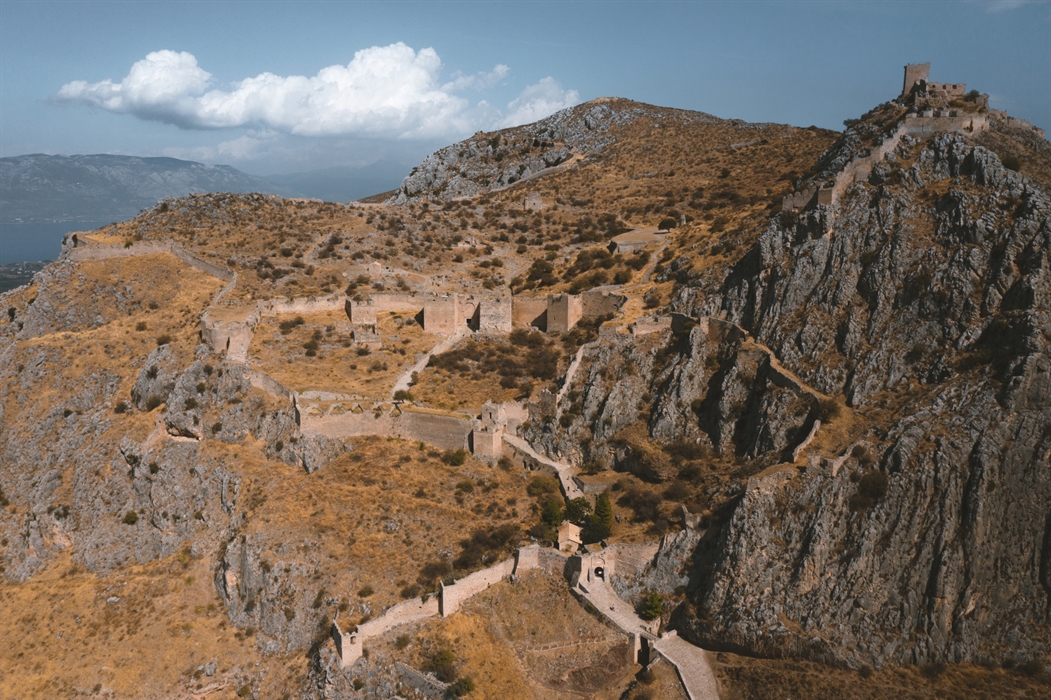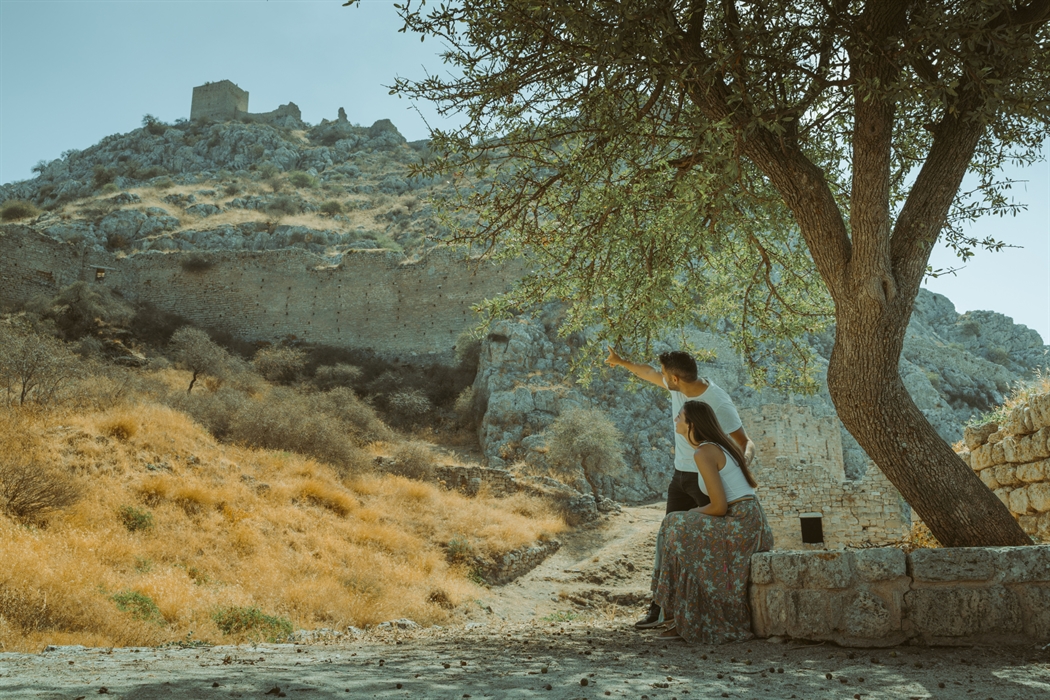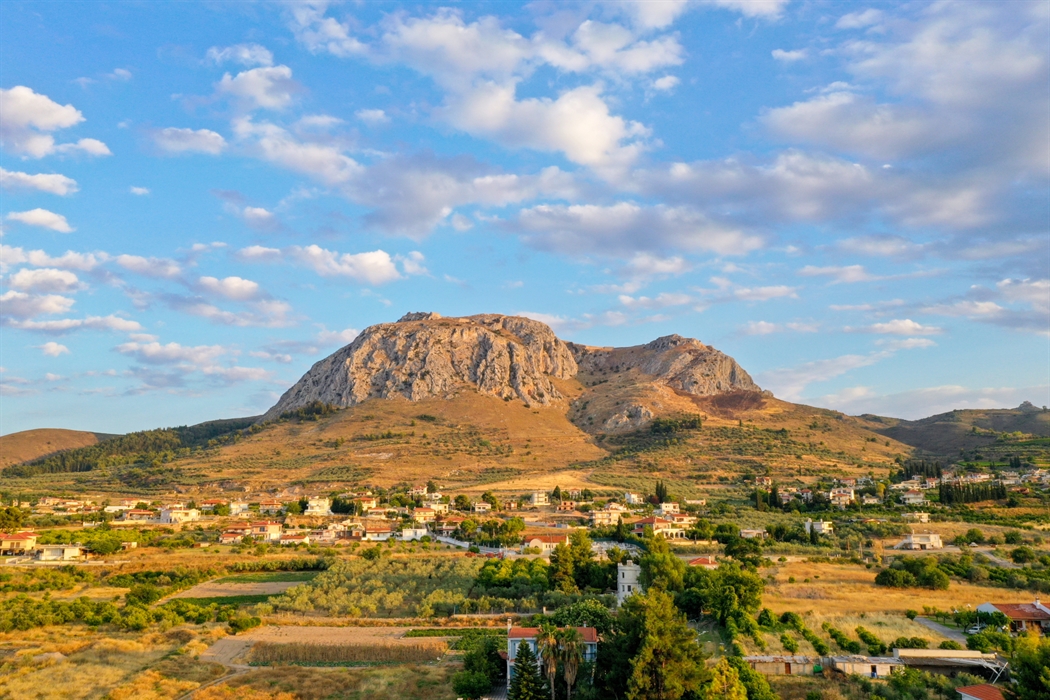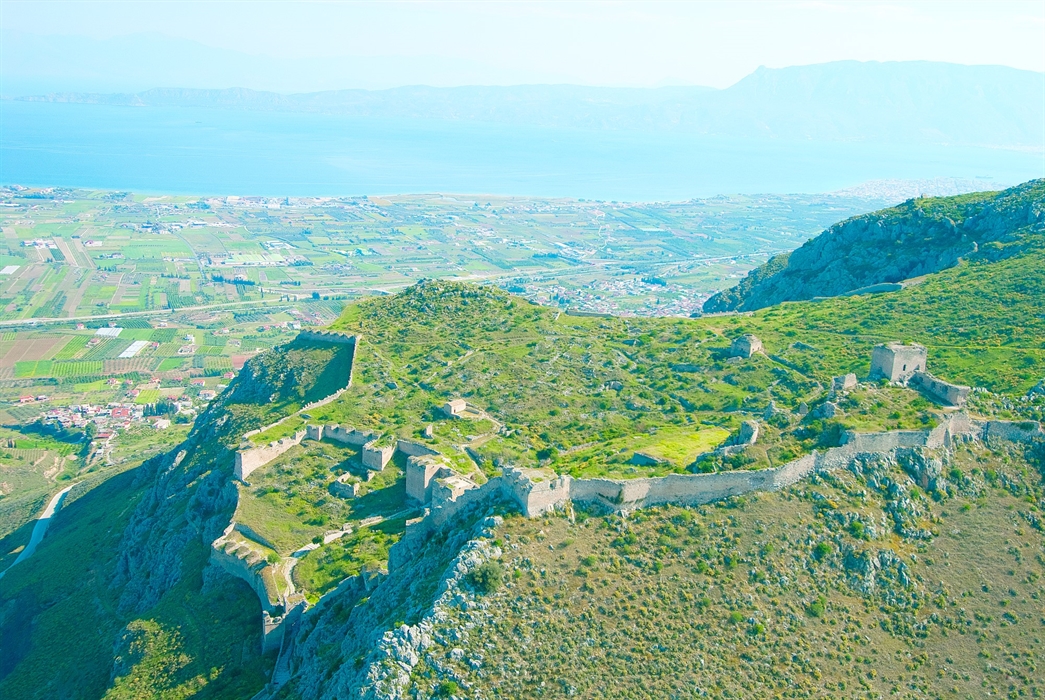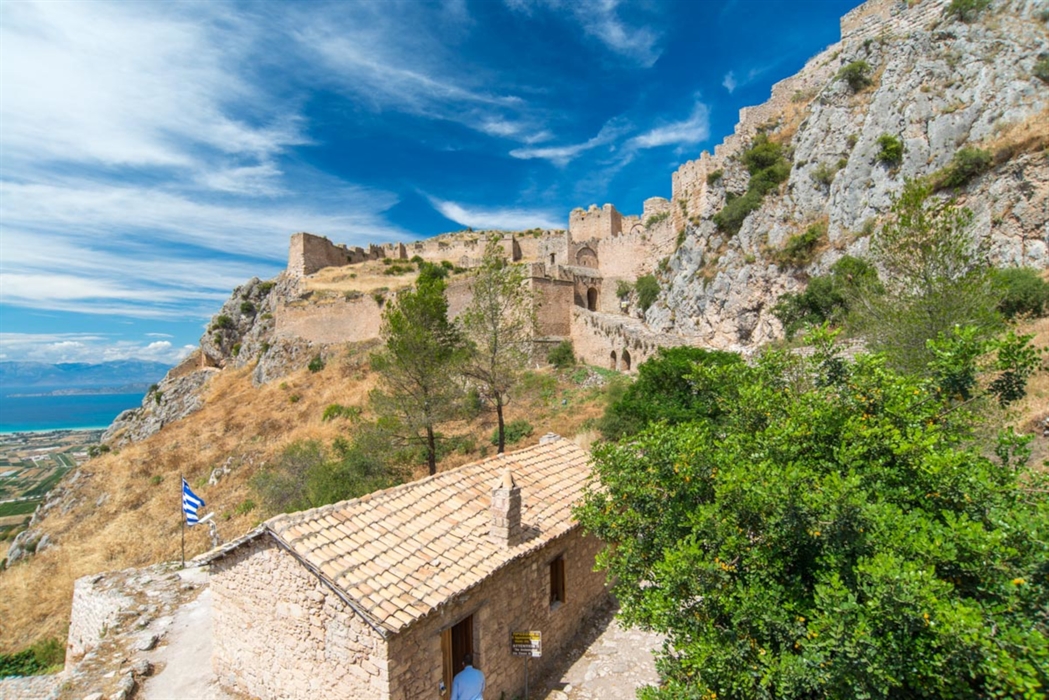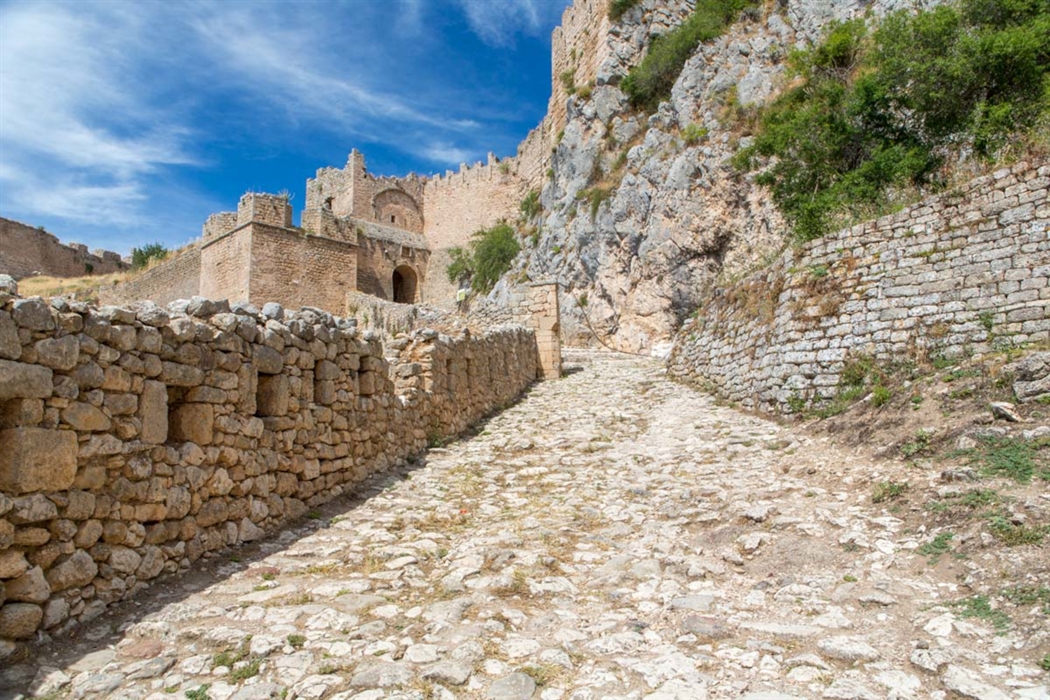Acrocorinth
Built on a steep rock, 575 meters high northwest of Ancient Corinth, rises the “All-seeing and Keeper of Keys of Peloponnese”, the impressive castle with the fortified acropolis of the ancient and medieval city.
Built on a steep rock, 575 meters high northwest of Ancient Corinth, rises the “All-seeing and Keeper of Keys of Peloponnese”, the impressive castle with the fortified acropolis of the ancient and medieval city. It is a monument of nature and people, who built here the most important fortification in the region, which evolved over the centuries.
The acropolis of Acrocorinth is the second oldest in Greece to be inhabited-following that of Athens. The temple of Aphrodite at the highest point of Acrocorinth is where the 360o view is epic. When the atmosphere is clear, you can see the Corinthian Bay, the Saronic Bay, the plains of Argos, Corinth, Cithaeron, Zireia, Mount Panachaikos, and Central Greece.
Glimpses into history. The first fortification was built in the late 7-6th century BC, under the tyranny of Kypselides. Large parts of the classical masonry date back to the 4th century BC. After the fortress’ destruction by the Romans in 146 C, Julius Caesar repaired it in 44 BC. Repairs were also made in the 6th century under the reign of Justinian, and some additions until the 12th century. In 1395, Theodoros Paleologos became the owner of the castle, and sold it to the Order of Saint John of Rhodes. He retrieved it in 1404. In 1458, sultan Mehmed II occupied Acrocorinth, and three mosques were built within it. In 1687, it passed into the hands of Venetians, who completed the fortifications in 1711. In 1715, after a siege, Acrocorinth was surrendered to the Turks, who made repairs and alterations, in order to modernise the fortification according to the new war technology of firearms.
In 1823, Corinth was liberated, and Abdullah Bey surrendered the castle to the Greek troops.
What you’ll see. The castle is typical of fortress architecture, with construction details reflecting its long history. The walls follow the natural shape of the rock. There are three lines of defence, reinforced with towers, bastions and crenelations with casemates.
A cobblestone street leads to three successive gates. The first one is arched, the second is an impressive tower-like structure, and the third one is flanked by two robust towers.
After the third series of walls spreads the space where you can see the ruins of the temple of Aphrodite dating back to the 5-4th century BC, a mosque of the 16th century, a minaret, a byzantine cistern, the castle of Villehardouin, the fountain of Ano Peirini, with two underground domed spaces (locals call it “Dragonera”).
On the northern foothills lie the ruins of the Agora of ancient Corinth, with monuments such as shrines, fountains, an odeon, a theatre, shops, the cobblestone Lechaiou street, the impressive archaic temple of Apollo. There lies the Museum, as well.
Spring is the ideal season to visit the castle, because colourful flowers bloom all around.
Read about the castle’s history.
Did you know that
The perimeter of Acrocorinth’ walls are about 3 km, and the tour can last up to 2 hours.
Entrance to Acrocorinth is free. Tel.: 27410 31266 (08:30-15:30).
It is 7 km away from Corinth.
Excavations conducted by the American School in 1926 on the highest oeak of Acrocorinth, proved the continuous use of the location from archaic times up to the early 19th century.
Resources: odysseus.culture, kastra.eu
History and Mythology
Mythology. According to the myth, in order to settle the dispute between Helios and Poseidon, the other gods decided that the former should keep the rock of Acrocorinth and the plain stretching below, and the latter that of Isthmus. Helios granted his rights to Aphrodite, the goddess of love and beauty. She was worshipped in Acrocorinth in a temple named after her. Sisyphus, the mythical king of Ephyra (Corinth) made a pact with river god Asopus, and in return he was given a spring on the rock of Acrocorinth, Peirini.
Glimpses into the history of Acrocorinth. The first fortification was built in the late 7-6th century BC, under the tyranny of Kypselides. Large parts of the classical masonry date back to the 4th century BC. In 338 BC, it passed into the hands of Macedonians, who were pursued by Aratus, and the city joined the Achaean League.
In 146 BC, the Roman General Lucius Mummius Achaicus destroyed Corinth and its acropolis, when he conquered Greece. Julius Caesar repaired the castle in 44 BC. Repairs were also made in the 6th century under the reign of Justinian, and some additions until the 12th century.
A remarkable incident in the history of Acrocorinth concerns Leon Sgouros, lord of Nauplio and Argos. He resisted the Franks, using the three castles of Peloponnese (Acronauplia, Larisa of Argos and Acrocorinth) as strongholds. In 1208, besieged in Acrocorinth by the Franks, it is said that he blindfolded his favourite horse, he opened a gate in the wall and jumped off a cliff along with it. Due to a lack of supplies, the castle was surrendered to the Franks in 1210.
In the mid-13th century, large repairs were made to the walls. In the early 14th century, the castle passed on to Prince John Gravina, then to N. Acciajuoli, who repaired the old fortifications and added new ones. In 1395, Theodoros Paleologos became the owner of the castle, and sold it to the Order of Saint John of Rhodes. He retrieved it in 1404. In 1458, sultan Mehmed II occupied Acrocorinth, and three mosques were built within it.
In 1687, it passed into the hands of Venetians, who completed the fortifications in 1711. In 1715, after a siege, Acrocorinth was surrendered to the Turks, who made repairs and alterations, in order to modernise the fortification according to the new war technology of firearms.
In 1823, Corinth was liberated, and Abdullah Bey surrendered the castle to the Greek troops.
Resources: odysseus.culture, Korinthos.gr, kastra.eu
Location
Find the destination on the interactive map below.
Categories
Weather
Σχετικό περιεχόμενο χρηστών (UGC)
Ενημερωθείτε για ενδιαφέροντα θέματα γύρω από τον προορισμό μέσα από το περιεχόμενο των χρηστών μας
Discover 7 hidden gems of the Peloponnese
Many of you may have already visited some of the most renowned attractions…
TOP 10 archaeological museums in the Peloponnese
Olympia, Mycenae, Epidaurus, Diros Cave, Ancient Corinth, Messene and…
TOP 10 Castles in the Peloponnese
Castles galore! Mystras, Monemvasia, Palamidi, Methoni, Koroni,…
Newsletters
- About us
- FAQ's
- Map
- Tourism information centers
- Disclaimer
- Sitemap
- Our brand
- Media roum
- Adding your bussiness
- Corporate
- MICE

Peloponnese. Greece beyond the obvious





Design and creation from Cosmote
Marinas and Moorings
Diving centers
Get inspired
- Media gallery
- Blog
- The Peloponnese in the media
- Your feedback
- Users' general content
- Users' local products
- Users' events content
- Ask a local
More
- Accommodation
- Travel agencies
- Restaurants
- Services
- Destinations Map
- Weather
- Public transport
- Events
- Frequently asked questions
- Useful phones
- B2B
- Destination Data
- Contact


